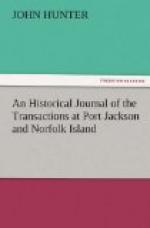On the 6th, Governor Phillip signified his intention of sending me to Norfolk-Island, with a few people, and stock to settle it, and lieutenant Ball was ordered to receive on board the Supply the stores and provisions necessary for that purpose: this business engaged the whole of my attention until the 15th, when, having received my commission and instructions from the governor, (and taken the oaths of fidelity and allegiance, etc. etc. and the customary oath as a justice of the peace for Norfolk-Island;) by which I was appointed superintendent and commandant of Norfolk-Island, I embarked the following persons, who were appointed to go along with me, viz. Mr. James Cunningham, master’s mate of the Sirius; Mr. Thomas Jameson, surgeon’s first mate of the Sirius; Mr. John Altree, assistant to the surgeon; Roger Morly, weaver; William Westbrook, and—— Sawyer, seamen; Charles Heritage, and John Batchelor, marines; with nine male and six female convicts; in all, twenty-three persons.
We sailed from Sydney-Cove at seven o’clock in the morning, with a fine breeze at west-south-west, and at eight, we got out of the harbour, when we found it blew very fresh, and as we got off the land it came on to blow a perfect hurricane, with a most tremendous sea running, which often broke into the vessel: the gale kept up with great violence, as did the sea during the whole day, and I often thought the vessel in a critical situation.
At two o’clock in the morning, the wind veered round to south-by-west, and moderated, but a heavy sea was still running. At noon, the latitude was 32 deg. 22’ south, 154 deg. 11’ east longitude. In the evening, a flying-fish flew on board, which is rather an extraordinary event in this latitude. At day-break in the morning of the 18th, land was discovered bearing east-south-east; and, from its appearance, we judged it to be two small rocks or islands, not more than six leagues distant. At the time we first saw the land, we were standing to the northward, with the wind at east-south-east: at eight in the morning, we tacked towards the land, but the wind being light during the whole day, our progress was very slow.
Early the next morning, having neared the land considerably, we perceived a pointed rock right a-head, at some distance from the island; on which, we hove to, and soundings were tried for with 120 fathoms of line, but we got no bottom. At day-light we made sail, and perceived that the two islands or hills we had seen the day before, were two very high rocky mountains, on the south side of an island, extending from north 37 deg. east, to north 55 deg. east. This side of the island formed a deep bay, in which there appeared to be good shelter from the north-east. At noon, we had a very good meridian altitude, by which the latitude was 31 deg. 40’ south, and the center of the island bore north 40 deg. west, distant about six miles; consequently, its latitude is 31 deg. 35’ south, and the longitude 159 deg. east of Greenwich.




